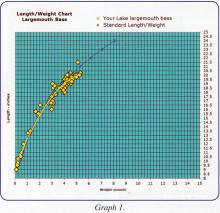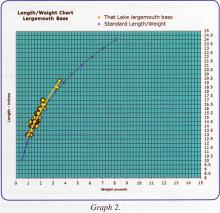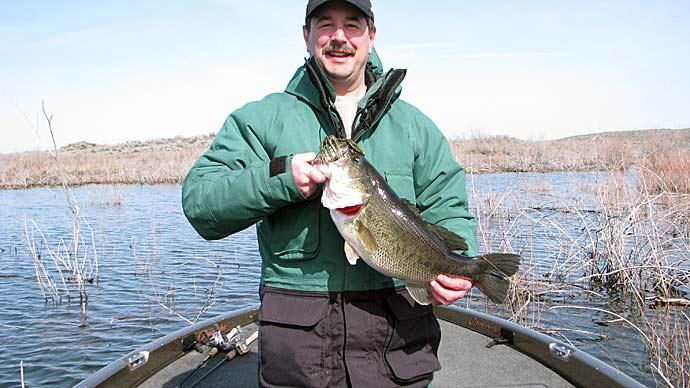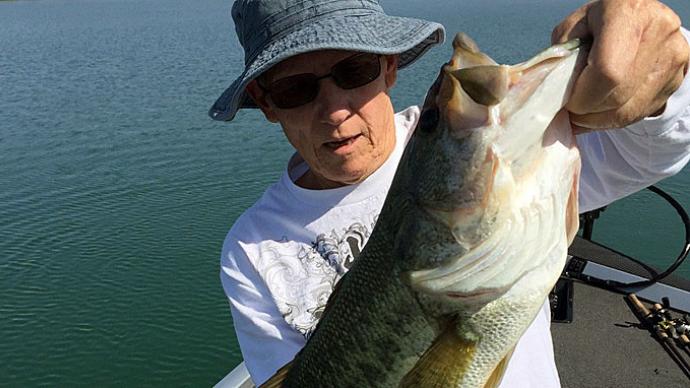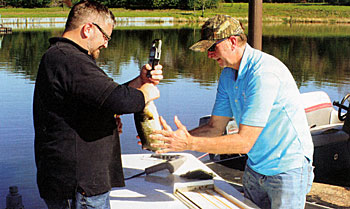
If I've heard this once, I've heard it hundreds of times. "I want to grow the biggest bass on the planet!"
As a professional fisheries biologist in the private sector, part of my job with clients is to help teach practical ways to track growth rates of their fish. Sure, you can catch fish and use common sense. That works pretty well. If you catch a fish and it's fat, that's good. If you catch skinny fish, that's not so good. But, what are some practical ways you can pay attention to that fishery in a proactive sense, using some fundamental science and math?
There are several motivational factors you need to know in order to have a snowball's chance of growing huge largemouth bass.
First, when baby fish enter this world, there's an automatic 50-50 chance they can't make it to double-digits. That's because half the bass hatched are boys. Boys don't grow large. Girls do. Second, if a bass doesn't get a meal today, it can't make up that day. Once a day of feeding is gone, it's gone for good. That bass loses a day of growth that it needs to push to its next size level. If your bass don't eat properly in their youth, you'll see it in their aging years, because they won't reach their genetic potential. In other words, if a bass has the genetic propensity to reach 15 pounds and it spends two or three years at 14 inches because it's competing too heavily in the food chain with its brothers, sisters, and cousins, it may only grow to 12 pounds before it runs out of time. Third, in order for a bass to reach a certain length, it must be near its "standard" weight. What that means is that in order for a bass to grow to 14 inches, it must weigh 1 lb., 7 ounces. If your 14 inch bass consistently weigh slightly over a pound, they've lost weight. Part of your goal should be to keep your target fish fat, all the time.
The number one problem trying to grow huge largemouth bass is harvesting overcrowded young fish while keeping the food chain flourishing. People think that "catch and release" is their ticket. Catch and release is ingrained in our souls.. .but should be viewed as a temporary solution to long term goals. Catch and release is one good tool in the fisheries management tool box, to be used with discretion. At some point, you MUST harvest bass. If you don't harvest, don't expect your bass population to reach its potential.
So, how can you know when to selectively harvest fish or to continue catch and release? Your fish will tell you, if you listen.
Weigh and measure your fish consistently. If you'll do that, and keep good records, you can see BEFORE your fish begin to lose weight.
Set up a datasheet where you can track the date, length, and weight of your bass. Keep any other notes you want, but you MUST keep dates, lengths, and weights. By tracking the dates, you can identify patterns of fish growth. By keeping lengths and weights, you'll get solid information for comparison. Then, enter your data into a spreadsheet. I use an Excel spreadsheet on my laptop. Create an x-y graph just like you learned in Algebra 1. Compare your fish to "Standard" lengths and weights for largemouth bass (or any species for that matter). If you are like most of us, and don't know how to create a spreadsheet on a computer for your bass, drop me a note and I'll email you mine... all you'll have to do is enter the data. It's simpler than you might think.
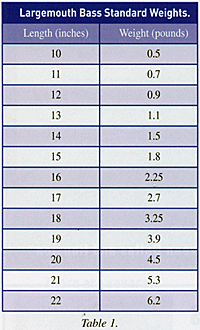
Take a look at Table 1. Largemouth Bass Standard Weights below. This is the table you should use to compare your bass. Weigh and measure your bass. Take the weight of your bass and divide it by the "Standard" weight below. That will give you a percentage of your fish compared to "Standard" bass. As long as you're within 10% of the Standard weight, your fish are "normal." If your Standard weight is 100% or greater, your bass are gaining weight.
Over time, you can compare your bass.
Compare them seasonally and look for patterns. In a young pond, bass grow fast. But, at some point, growth will begin to level off in certain size classes of bass. That's because that particular size range of bass is becoming overcrowded and they are overeating their food chain. Your job is to recognize when this happens and prepare to be proactive, rather than reactive. If you react to a problem, you've lost valuable time that your bass need to be able to continue those healthy growth trends.
Next, look at Graph 1. The blue curve represents "Standard" weights for given lengths. Each yellow diamond represents a bass in our sample lake. The yellow diamonds to the left of the curve represents underweight fish. Those to the right are fat, healthy bass. Just for the record, this is a true sampling of bass from a lake where feed-trained largemouth bass were introduced. The larger fish to the right of the curve represent bass on feed. Most of the other fish represent a reproducing population of bass feeding on a forage fish base composed mostly of bluegill and redear sunfish.
Graph 1 shows a population of bass in the 9-13 inch size class growing into the food chain. Right now, those bass are in fairly good shape, but they are feeding lower on the food chain than the larger fish. Inevitably, these will be the bass which will overeat their segment of the food chain...eating newly hatched fish. When that happens, we'll see most of the bass begin to lose weight. If you think about it, that makes sense. Since this lake depends on bluegill and redear sunfish as its primary source of food, when the small bass decimate baby fish those little fish won't have the opportunity to grow to larger sizes...thus impacting the larger bass' native food chain. That makes fish food for feed-trained bass mandatory.
Next, look at Graph 2. This fishery is on the cusp of mandatory selective harvest. See how the trends are toward the left of the graph, and the fish are bunched up? These bass were electrofished last February from a shallow central Texas lake. This is a classic example where a slot limit should be initiated for 12-15 inch bass, with a caveat. If an angler catches a fat, healthy bass in the 15" class, release it. But, removing all "average" or "below average" bass in that size class would help this fish population.
You might ask, "Why not remove some of the larger bass in this lake?" We figured out many of these bass were in the same age class, but not necessarily in the same size class. That means the bass in this lake that were 15-17" were close to the same age, so if we preserve those larger ones, we're saving the fastest growing bass in that population.
Okay, enough of this talk. What should you do? Track your dates, lengths, and weights. Compare different time ranges to see how your fish are performing. Compare the third quarter of 2012 to the third quarter of 2013 and you can see if your fishery is performing...or not. By comparing data over longer periods of time, you'll waste less time waiting to make choices of what bass to harvest, when.
Using some basic math, you can track your bass and figure out how to be a better fisheries manager.
Reprinted with permission from Pond Boss Magazine

